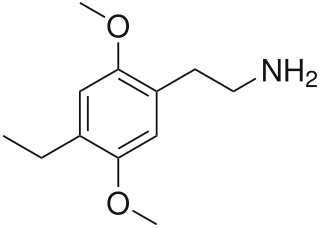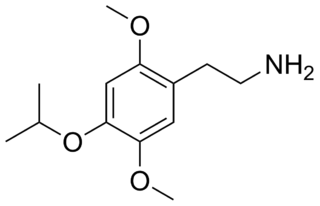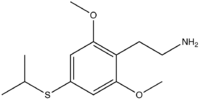
2C-T-7 is a psychedelic phenethylamine of the 2C family. In his book PiHKAL: A Chemical Love Story, Alexander Shulgin lists the dosage range as 10 to 30 mg. 2C-T-7 is generally taken orally, and produces psychedelic and entactogenic effects that last 8 to 15 hours. Up until Operation Web Tryp and three deaths, two of which involved the use of other drugs in addition to 2C-T-7, and one which involved an excessive insufflated dose, 2C-T-7 was sold commercially in Dutch and Japanese smartshops and online. It is known on the streets as Blue Mystic or 7th Heaven. There has been little real research done on this chemical other than Shulgin's comments in PiHKAL and a few small animal studies mostly aimed at detecting metabolites.

2C-E is a psychedelic phenethylamine of the 2C family. It was first synthesized by Alexander Shulgin and documented in his book PiHKAL. Like the other substances in its family, it produces sensory and cognitive effects in its physical reactions with living organisms.

2C-T-2 is a psychedelic and entactogenic phenethylamine of the 2C family. It was first synthesized in 1981 by Alexander Shulgin, and rated by him as one of the "magical half-dozen" most important psychedelic phenethylamine compounds. The drug has structural and pharmacodynamic properties similar to those of 2C-T-7.

2C-C is a psychedelic drug of the 2C family. It was first synthesized by Alexander Shulgin, sometimes used as an entheogen. In his book PiHKAL , Shulgin lists the dosage range as 20–40 mg. 2C-C is usually taken orally, but may also be insufflated. 2C-C is schedule I of section 202(c) of the Controlled Substances Act in the United States, signed into law as of July, 2012 under the Food and Drug Administration Safety and Innovation Act.

2C-D is a psychedelic drug of the 2C family that is sometimes used as an entheogen. It was first synthesized in 1970 by a team from the Texas Research Institute of Mental Sciences, and its activity was subsequently investigated in humans by Alexander Shulgin. In his book PiHKAL, Shulgin lists the dosage range as being from 20 to 60 mg. Lower doses of 10 mg or less have been explored for microdosing.

2C-T-21 is a psychedelic phenethylamine of the 2C family sometimes used as an entheogen. It was first synthesized by Alexander Shulgin.

2C-T-8 is a psychedelic phenethylamine of the 2C family. It was first synthesized by Alexander Shulgin, sometimes used as an entheogen.

2C-N (2,5-dimethoxy-4-nitrophenethylamine) is a psychedelic phenethylamine of the 2C family. It was first synthesized by Alexander Shulgin.

2C-P is a relatively potent and long acting psychedelic phenethylamine of the 2C family.

5-MeO-MiPT is a psychedelic and hallucinogenic drug, used by some as an entheogen. It has structural and pharmacodynamic properties similar to the drugs 5-MeO-DiPT, DiPT, and MiPT. It is commonly used as a "substitute" for 5-MeO-DiPT because of the very similar structure and effects.

2,5-Dimethoxy-4-chloroamphetamine (DOC) is a psychedelic drug of the phenethylamine and amphetamine chemical classes. It was presumably first synthesized by Alexander Shulgin, and was described in his book PiHKAL.

2C-T is a psychedelic and hallucinogenic drug of the 2C family. It is used by some as an entheogen. It has structural and pharmacodynamic properties similar to the drugs mescaline and 2C-T-2.

2C-TFM is a psychedelic phenethylamine of the 2C family. It was first synthesized in the laboratory of David E. Nichols. It has also been called 2C-CF3, a name derived from the Para-trifluoromethyl group it contains.

2C-O-4 (4-isopropoxy-2,5-dimethoxyphenethylamine) is a phenethylamine of the 2C family. It is also a positional isomer of isoproscaline and was probably first synthesized by Alexander Shulgin. It produces hallucinogenic, psychedelic, and entheogenic effects. Because of the low potency of 2C-O-4, and the inactivity of 2C-O, Shulgin felt that the 2C-O series would not be an exciting area for research, and did not pursue any further analogues.

Isoproscaline or 4-isopropoxy-3,5-dimethoxyphenethylamine is an analog of mescaline. It is closely related to proscaline and was first synthesized by David E. Nichols. It produces hallucinogenic, psychedelic, and entheogenic effects.

2,5-Dimethoxy-4-ethylamphetamine is a psychedelic drug of the phenethylamine and amphetamine chemical classes. It was first synthesized by Alexander Shulgin, and was described in his book PiHKAL.

Aleph is a psychedelic hallucinogenic drug and a substituted amphetamine of the phenethylamine class of compounds, which can be used as an entheogen. It was first synthesized by Alexander Shulgin, who named it after the first letter of the Hebrew alphabet. In his book PiHKAL, Shulgin lists the dosage range as 5–10 mg, with effects typically lasting for 6 to 8 hours.

2C-T-13 is a psychedelic phenethylamine of the 2C family. It was presumably first synthesized by Alexander Shulgin and reported in his book PiHKAL.

2C-T-15 or 2,5-dimethoxy-4-(β-cyclopropylthio)phenethylamine is a psychedelic phenethylamine of the 2C family. It was presumably first synthesized by Alexander Shulgin and reported in his book PiHKAL .

2C-T-17 or 2,5-dimethoxy-4-(β-secbutylthio)phenethylamine is a psychedelic phenethylamine of the 2C family. It was presumably first synthesized by Alexander Shulgin and reported in his book PiHKAL .






















